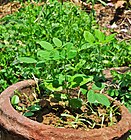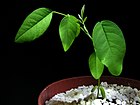Note: This is a project under development. The articles on this wiki are just being initiated and broadly incomplete. You can Help creating new pages.
Difference between revisions of "Clitoria ternatea - Aparajita"
Chaithrika (talk | contribs) (+adding internal link) |
(→References) |
||
| (46 intermediate revisions by 3 users not shown) | |||
| Line 1: | Line 1: | ||
[[File:Starr 980529-1406 Clitoria ternatea.jpg|thumb|right|''Aparajita'', '' Clitoria ternatea'']] | [[File:Starr 980529-1406 Clitoria ternatea.jpg|thumb|right|''Aparajita'', '' Clitoria ternatea'']] | ||
| + | '''Clitoria ternatea''' is a plant species belonging to the Fabaceae family. The flowers of this vine have the shape of human female genitals. Hence the Latin name of the genus "Clitoria" from "clitoris". | ||
| + | ==Uses== | ||
| + | {{Uses|Chronic bronchitis}}, {{Uses|Migraine}}, {{Uses|Recurrent fever}}, {{Uses|Chronic cough}}, {{Uses|Tonsillitis}}, {{Uses|Abdominal pain}}, {{Uses|Hydrocele}}, {{Uses|Uterus Prolapse}}, {{Uses|Gonorrhoea}}, {{Uses|Heavy Periods}}, {{Uses|Hydrocele}}. | ||
| + | ==Parts Used== | ||
| + | {{Parts Used|Seeds}}, {{Parts Used|Leaves}}, {{Parts Used|Roots}}. | ||
| − | + | ==Chemical Composition== | |
| + | Major flavonol glycosides, 3-O-(2"-O-alpha-rhamnosyl-6"-O-malonyl)-beta-glucoside, 3-O-(6"-O-alpha-rhamnosyl-6"-O-malonyl)-beta-glucoside and 3-O-(2",6"-di-O-alpha-rhamnosyl)-beta-glucoside of kaemferol, quercetin and myricetin were isolated from the petals<ref name="chemical composition"/> | ||
| + | ==Common names== | ||
| + | {{Common names|kn=Aparijata, Girikarnike|ml=Sangu Pushpam|sa=Ghrstih, Aparajita, Radha, Adrikarni|ta=Sankupushpam, Kakkanam|te=Sankhu-pushpamu|hi=Khagin|en=Clitoria, Butterfly Bean}} | ||
| − | == | + | ==Properties== |
| + | Reference: Dravya - Substance, Rasa - Taste, Guna - Qualities, Veerya - Potency, Vipaka - Post-digesion effect, Karma - Pharmacological activity, Prabhava - Therepeutics. | ||
| + | ===Dravya=== | ||
| + | ===Rasa=== | ||
| + | Tikta (Bitter), Kashaya (Astringent), Katu (Pungent) | ||
| + | ===Guna=== | ||
| + | Laghu (Light), Ruksha (Dry) | ||
| + | ===Veerya=== | ||
| + | Sheeta (Cold potency) | ||
| + | ===Vipaka=== | ||
| + | Katu (Pungent) | ||
| + | ===Karma=== | ||
| − | + | ===Prabhava=== | |
| − | |||
| − | + | ==Habit== | |
| − | + | {{Habit| A small shrub}} | |
| − | == | + | ==Identification== |
| + | ===Leaf=== | ||
| + | {{Leaf|Imparipinnate|Ovate|Leaf Arrangement is Alternate distichous, Leaf Apex is Obtuse, Leaf Base is Obtuse and Leaf Margin is Entire}}.<ref name="Leaf"/> | ||
| − | + | ===Flower=== | |
| + | {{Flower|Solitary|2-4cm long|Deep blue, occasionally white|8-10|Flowering from March-May}} | ||
| + | ===Fruit=== | ||
| + | {{Fruit|Oblong pod|Fruit is linear||Seeds 10-15|Fruiting throughout the year}} | ||
| − | == | + | ===Other features=== |
| + | ==List of Ayurvedic medicine in which the herb is used== | ||
| + | * [[Garbhapala rasa]] | ||
| + | * [[Vataraktantak rasa]] | ||
| + | <ref name="Ayurvedic preparations"/> | ||
| + | |||
| + | ==Where to get the saplings== | ||
| + | ==Mode of Propagation== | ||
| + | {{Propagation|Seeds}}. | ||
| + | |||
| + | ==How to plant/cultivate== | ||
| + | Can be easily grown from seed. Butterfly pea is essentially a plant of the humid and subhumid tropical lowlands at elevations from sea level to around 1,600 metre <ref name="How to plant/cultivate"/> | ||
| + | |||
| + | ==Commonly seen growing in areas== | ||
| + | {{Commonly seen|Tropical area}} | ||
| + | |||
| + | ==Photo Gallery== | ||
| + | <gallery class="left" caption="" widths="140px" heights="140px"> | ||
| + | File:Clitoria ternatea in jaffna.JPG | ||
| + | File:Clitoria ternatea 17 07 2013.jpg | ||
| + | File:Clitoria ternatea plants 15042014.jpg | ||
| + | File:Clitoria ternatea20130613 03.jpg | ||
| + | File:Clitoria ternatea20130624 07.jpg | ||
| + | File:Clitoria ternatea20130714 29.jpg | ||
| + | File:Starr_980529-1406_Clitoria_ternatea.jpg | ||
| + | File:Butterfly Pea (4203107242).jpg|Pods | ||
| + | File:Clitoria ternatea (2375910043).jpg|Seeds | ||
| + | </gallery> | ||
| + | |||
| + | ==References== | ||
<references> | <references> | ||
| − | <ref name=" | + | <ref name="chemical composition">[http://www.globinmed.com/index.php?option=com_content&view=article&id=80348:clitoria-ternatea-2&catid=705:c Chemical Constituents]</ref> |
| + | <ref name="Leaf">Kappatagudda - A Repertoire of Medicianal Plants of Gadag by Yashpal Kshirasagar and Sonal Vrishni, Page No. 133</ref> | ||
| + | <ref name="How to plant/cultivate">[http://tropical.theferns.info/viewtropical.php?id=Clitoria+ternatea Cultivation details]</ref> | ||
| + | <ref name="Ayurvedic preparations">[https://easyayurveda.com/2012/12/07/aparajita-clitoria-ternatea-ayurvedic-explanation-of-medicinal-use/ Ayurvedic preparations]</ref> | ||
</references> | </references> | ||
| + | ==External Links== | ||
| + | * [https://www.researchgate.net/publication/248390954_Chemical_composition_and_anti-proliferative_properties_of_flowers_of_Clitoria_Ternatea Chemical composition and anti-proliferative properties of flowers of Clitoria Ternatea] | ||
| + | * [http://www.indianmedicinalplants.info/d3/Clitoria-ternatea(Aparajita).html Clitoria ternatea on Encyclopedia of Ayurvedic Medicinal Plants] | ||
| + | |||
| + | * [http://www.missouribotanicalgarden.org/PlantFinder/PlantFinderDetails.aspx?taxonid=280445 Clitoria ternatea on missuori botonical garden] | ||
| + | * [https://garden.org/plants/view/86881/Butterfly-Pea-Clitoria-ternatea/ Clitoria ternatea on plants datbase] | ||
[[Category:Herbs]] | [[Category:Herbs]] | ||
| + | [[Category:Fabaceae]] | ||
Latest revision as of 16:25, 30 April 2021
Clitoria ternatea is a plant species belonging to the Fabaceae family. The flowers of this vine have the shape of human female genitals. Hence the Latin name of the genus "Clitoria" from "clitoris".
Contents
- 1 Uses
- 2 Parts Used
- 3 Chemical Composition
- 4 Common names
- 5 Properties
- 6 Habit
- 7 Identification
- 8 List of Ayurvedic medicine in which the herb is used
- 9 Where to get the saplings
- 10 Mode of Propagation
- 11 How to plant/cultivate
- 12 Commonly seen growing in areas
- 13 Photo Gallery
- 14 References
- 15 External Links
Uses
Chronic bronchitis, Migraine, Recurrent fever, Chronic cough, Tonsillitis, Abdominal pain, Hydrocele, Uterus Prolapse, Gonorrhoea, Heavy Periods, Hydrocele.
Parts Used
Chemical Composition
Major flavonol glycosides, 3-O-(2"-O-alpha-rhamnosyl-6"-O-malonyl)-beta-glucoside, 3-O-(6"-O-alpha-rhamnosyl-6"-O-malonyl)-beta-glucoside and 3-O-(2",6"-di-O-alpha-rhamnosyl)-beta-glucoside of kaemferol, quercetin and myricetin were isolated from the petals[1]
Common names
| Language | Common name |
|---|---|
| Kannada | Aparijata, Girikarnike |
| Hindi | Khagin |
| Malayalam | Sangu Pushpam |
| Tamil | Sankupushpam, Kakkanam |
| Telugu | Sankhu-pushpamu |
| Marathi | NA |
| Gujarathi | NA |
| Punjabi | NA |
| Kashmiri | NA |
| Sanskrit | Ghrstih, Aparajita, Radha, Adrikarni |
| English | Clitoria, Butterfly Bean |
Properties
Reference: Dravya - Substance, Rasa - Taste, Guna - Qualities, Veerya - Potency, Vipaka - Post-digesion effect, Karma - Pharmacological activity, Prabhava - Therepeutics.
Dravya
Rasa
Tikta (Bitter), Kashaya (Astringent), Katu (Pungent)
Guna
Laghu (Light), Ruksha (Dry)
Veerya
Sheeta (Cold potency)
Vipaka
Katu (Pungent)
Karma
Prabhava
Habit
Identification
Leaf
| Kind | Shape | Feature |
|---|---|---|
| Imparipinnate | Ovate | Leaf Arrangement is Alternate distichous, Leaf Apex is Obtuse, Leaf Base is Obtuse and Leaf Margin is Entire |
.[2]
Flower
| Type | Size | Color and composition | Stamen | More information |
|---|---|---|---|---|
| Solitary | 2-4cm long | Deep blue, occasionally white | 8-10 | Flowering from March-May |
Fruit
| Type | Size | Mass | Appearance | Seeds | More information |
|---|---|---|---|---|---|
| Oblong pod | Fruit is linear | Seeds 10-15 | Fruiting throughout the year | {{{6}}} |
Other features
List of Ayurvedic medicine in which the herb is used
Where to get the saplings
Mode of Propagation
How to plant/cultivate
Can be easily grown from seed. Butterfly pea is essentially a plant of the humid and subhumid tropical lowlands at elevations from sea level to around 1,600 metre [4]
Commonly seen growing in areas
Photo Gallery
References
- ↑ Chemical Constituents
- ↑ Kappatagudda - A Repertoire of Medicianal Plants of Gadag by Yashpal Kshirasagar and Sonal Vrishni, Page No. 133
- ↑ Ayurvedic preparations
- ↑ Cultivation details
External Links
- Ayurvedic Herbs known to be helpful to treat Chronic bronchitis
- Ayurvedic Herbs known to be helpful to treat Migraine
- Ayurvedic Herbs known to be helpful to treat Recurrent fever
- Ayurvedic Herbs known to be helpful to treat Chronic cough
- Ayurvedic Herbs known to be helpful to treat Tonsillitis
- Ayurvedic Herbs known to be helpful to treat Abdominal pain
- Ayurvedic Herbs known to be helpful to treat Hydrocele
- Ayurvedic Herbs known to be helpful to treat Uterus Prolapse
- Ayurvedic Herbs known to be helpful to treat Gonorrhoea
- Ayurvedic Herbs known to be helpful to treat Heavy Periods
- Herbs with Seeds used in medicine
- Herbs with Leaves used in medicine
- Herbs with Roots used in medicine
- Herbs with common name in Kannada
- Herbs with common name in Hindi
- Herbs with common name in Malayalam
- Herbs with common name in Tamil
- Herbs with common name in Telugu
- Herbs with common name in Sanskrit
- Herbs with common name in English
- Habit - A small shrub
- Index of Plants which can be propagated by Seeds
- Herbs that are commonly seen in the region of Tropical area
- Herbs
- Fabaceae









